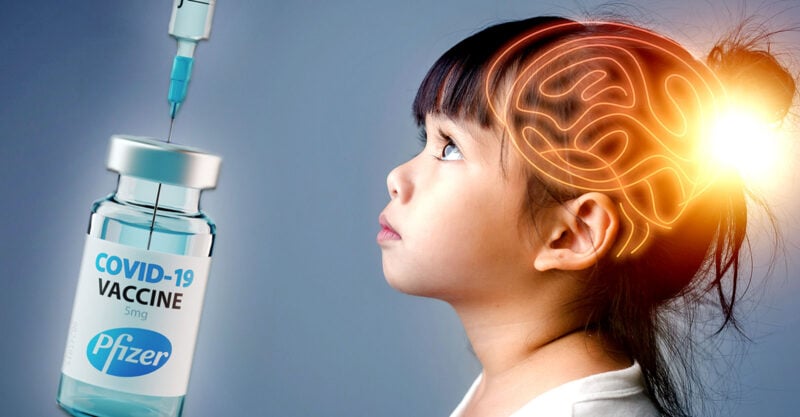Pfizer’s COVID Vaccine Caused Autism-Like Behaviors in Offspring of Rats Vaccinated During Pregnancy
Pfizer’s BNT162b COVID-19 vaccine administered to pregnant rats was associated with significant structural and biochemical changes in the brains of offspring and noticeable deficits in several behavioral domains. These effects may not directly relate to humans, and the study period did not allow for the possibility that these effects are reversible.
Miss a day, miss a lot. Subscribe to The Defender's Top News of the Day. It's free.
COVID-19 mRNA gene therapies (“vaccines”) were likely the first injectable medicines recommended for pregnant women based on just 11 weeks of testing — even though according to the U.S. Food and Drug Administration, the average time required to test a drug for safety is eight-and-a-half years.
Now, a Turkish study in Neurochemical Research, by Mumin Alper Erdogan et al., suggests administering the mRNA vaccines to pregnant women may cause neurodevelopmental harm to their children.
Researchers studied the offspring of pregnant rats that received Pfizer’s BNT162b2 mRNA vaccine. Specifically, they examined the rats’ neurodevelopment-related behaviors, motor performance and changes in brain chemistry affecting neurodevelopment.
The researchers found very large differences in the expression of some proteins and genes, suggesting that these changes were responsible for the observed behavioral and performance deficits.
This effect was most obvious in male rats, which exhibited “pronounced autism-like behaviors” such as reduced social activity and repetitive behavior.
Males also showed impaired coordination and agility, and a large decrease in populations of certain brain cells.
How the study was designed
Pregnant female rats received either a placebo shot of sterile salt water or a dose of the BNT162b2 vaccine. To ensure that all pups received the same level of maternal care investigators allowed mothers to keep only four offspring, which they nursed for 21 days.
At the end of the 21 days, 41 young rats survived: 10 males and 10 females born to rats that received the placebo, and 13 males and 8 females born to rats that were vaccinated.
The test animals were separated by sex and treatment category (male or female, treated or untreated) and raised separately until they were 50 days old, when behavioral assessments began.
Rats underwent four standard rat-behavior tests to observe their preference for social versus nonsocial activity, time spent with strangers or unfamiliar objects, interest in exploration or “investigative” behavior and motor coordination.
After mice underwent behavioral tests researchers sacrificed groups of three or four mice from treated or untreated, male or female groups and extracted their brains to quantify differences in brain structure, type of nerve cells present, and levels of chemicals and genes associated with autistic behavior.
Throughout behavioral and laboratory testing researchers used statistics that allowed them to quantify differences between male-female and treated-untreated rats.
Sex differences in some behaviors, not others
Investigators found no sex-associated differences in the combined results of behavioral measures of sociability or social novelty, which led them to report that “the vaccine’s effects on these social behaviors were not differentially modulated by sex.”
A result that came very close to statistical significance was uncovered for one measure — “novelty index,” a term rarely used in rat studies.
Erdogan et al. defined the novelty index as “the time the rat spends in the chamber with ‘stranger 2’ … [divided] by the time spent in the chamber with the previously introduced ‘stranger 1.’” In other words, this metric quantifies a rat’s readiness to engage with strangers after an initial “stranger” experience.
However, when they combined the novelty index with other social interaction measures they observed no meaningful inter-sex differences.
Sex differences were found, however, in two other behavioral tests: “time to fall” and “sociability.”
“Time to fall” or “latency time to fall” (the authors’ terminology) measures the time a rat maintains its balance on rod rotating at different speeds — a measure of motor skills and endurance.
Among rats whose mothers received the BNT162b2 vaccine during gestation, males performed much worse than females. However, male-female differences disappeared within the placebo-treated group.
Additionally, when comparing the vaccinated versus placebo groups within each sex, the very large, statistically significant differences among males vanished in females.
A similar pattern emerged for other sociability measures.
Although no differences were observed for sex or mother’s vaccination status in an animal’s relative preference for a second “stranger” over the first stranger, male offspring of vaccinated mothers were far less likely to engage in the initial unfamiliar experience in the first place.
Animals in the vaccinated group also spent significantly less time with the second stranger than placebo-group rats.
On their behavioral test results, Erdogan et al. concluded:
“While the vaccine’s impact on social interaction parameters did not vary between sexes, motor performance was significantly affected in a sex-dependent manner in the vaccinated group. This underscores the importance of considering sex as a biological variable in vaccine research and highlights the need for targeted studies to further explore the implications of these sex-specific effects.”
Male rats in vaccine group had lower counts of specialized nerve cells associated with physical coordination
Male rats in the vaccine group showed significantly fewer cells in the CA1 and CA3 regions of the hippocampus compared with male offspring of unvaccinated mothers, and lower counts of Purkinje cells — specialized nerve cells — in the cerebellum. The authors did not specifically address the significance of these findings in their discussion.
In humans, Purkinje cells are responsible for physical coordination and affect some behavioral and emotional responses. The hippocampal A1 region governs spatial memory and the CA3 region is involved in seizures and neurodegeneration — but again, the authors did not discuss the meaning of these differences in the context of their study.
The researchers also looked for evidence of inflammation-mediating cytokines in rat brains, for example, several interleukins and tumor necrosis factor-alpha, but found no significant differences between the sexes or vaccine groups.
However, brain-derived neurotrophic factor (BDNF) levels were significantly lower in both male and female offspring of vaccinated mothers compared to offspring from placebo-treaded dams.
BDNF, which is present in the central nervous system, gut and other tissues, participates in neuronal survival and growth, controls the activity of neurotransmitters, and affects neuronal plasticity — an essential factor in learning and memory.
Gene expression showed similarly large sex and treatment effects. For example, expression of the mTOR gene was significantly higher and WNT expression significantly lower between vaccine group and placebo group males.
WNT genes in humans are precursors to 19 different, structurally related protein growth factors that govern cell activity and health during development. In adults, WNT-derived proteins keep the body’s biological functions working properly, while inappropriately activated WNT has been implicated in cancer and other diseases.
mTOR (mechanistic target of rapamycin kinase) is a gene whose two protein products control protein production, cell growth and how cells respond to stresses like DNA damage and nutrient deprivation. Sirolimus, an mTOR blocker, prevents post-transplantation organ rejection.
Pregnant rats received adult human dose
Although some of the effects of maternal vaccination on gene and protein levels, particularly male-female differences, were highly significant, Erdogan et al. failed to argue convincingly for their connection to equally profound behavioral deficits.
For example, after describing hippocampal differences in detail in the “Results” section and referring to CA1 and CA3 regions as “designated regions for injury assessment” neither CA1 nor CA3 were mentioned in the discussion.
The authors did note how their results track male-female differences in human autism studies and the peril of extrapolating results from rat studies to humans.
The most glaring problem with Erdogan et al., however, was that pregnant rats received the same BNT162b2 dose — 30 micrograms — as is given to adult humans. Assuming an average adult human female weight of 170 pounds and a typical rat weight of about 1 pound, the rats received around 170 times the human dose.
Erdogan et al. did not mention dosage in their discussion either, despite medicine’s long appreciation for the relationship between dose, response and safety, and existing evidence that even doubling the dose of BNT162b2 raises safety risks.
Finally, Erdogan did not clarify the timing of their interventions generally, or the relative scheduling of vaccine versus placebo administration. The first concern is minor because rats were dosed on day 13 — the midway point in their gestation period — and human females presumably could get the shot at any point.
The relative timing of vaccine and placebo administration in the study, however, was unclear. Erdogan et al. wrote that rats received the vaccine “on the thirteenth day of gestation” but placebo rats were dosed “on the same day of pregnancy.”
This can mean either “same day as vaccinated rats,” that is gestation day 13, or on the day they became pregnant. If the latter then their timing may have affected their results.
Erdogan et al. acknowledged that more studies were needed to confirm that these observations apply to humans, as “a comprehensive understanding of the risks and rewards of COVID-19 vaccination, especially during pregnancy, remains essential.”
Sign up for free news and updates from Children’s Health Defense. CHD focuses on legal strategies to defend the health of our children and obtain justice for those injured. We can't do it without your support.






